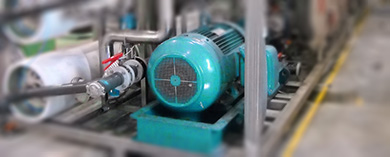
- (03) 5909 8218
- enquiry@fusionweld.com.au
Skid Mounted systems for Gas Compression
September 25, 2014

A gas compression infrastructure typically includes a compressor and a series of components designed to remove particulate matter from the gas as it's transmitted through a network of pipes. The compressor sits at the heart of the fabricated system of parts, reducing the volume of the gas for storage, or passing the pressurized mass onto a secondary stage for further processing. Without labeling any particular industry just yet, the pressurized gas is reduced into a dense state, still gaseous, or further condensed into a liquid form. The advent of modular engineering aids in assigning the correct configuration of gas compression to an engineering application, and it's the maturation of skid technology that's simplifying this approach.
The reduced footprint of a skid-mounted assembly places all of the components of a working system on one steel base plate, a robust common bundle of mechanical drivers, auxiliary parts, pipes and input/output stages complete with filtration. Generally speaking, the manufacturing process is conducted at the fabrication shop, using blueprints to weld every pipe, vessel, and platform in place. The skid is also outfitted with electrical fit-out wiring, compartments, and instrumentation. The inclusion of the fit-out makes it a breeze to hook up one or more electrical motors to the compressor shaft, and the only task left is to decide on the configuration of the central compressor, to opt for a reciprocal or rotary cycle of compression.
The viability of a modular gas compression skid lays in ease of construction, in the ability to lever superior quality control at the fabrication yard. The standard workflow pieces the structure together, adding platforms and accessibility features, before integrating the skid within its working environment. Engineering specifications will vary depending on an application, but a gas scrubber is a consistent part of the fabricated structure, an in-line component that removes suspended water droplets and fine particles. If the processed substance in question is natural gas, further filtration stages are introduced to clean the raw material of pollutants, intrusive substances, including water, carbon dioxide, and the noxious sulfides that have combined with the gas deep below the ground.
The assemblage of pipes and vessels welded and bolted to a skid-mounted gas compression system act as a processing stage, cleaning the gas, reducing its volume, all in preparation for storage or distribution through a network of pipes. In accordance with design specifications, the vessels and auxiliary components are rated for the operating pressure as set by the compression sub-assembly, but there are other applications worthy of note for these hardy structures. A gas compression system fits in immediately in oil refineries and offshore platforms, but they're also intrinsic parts of more dynamic systems. Biofuels are condensed for storage and transport by the skid-mounted assemblies, as is the gas destined for ignition in power stations. The gas turbines, industrial boiler fuel systems, furnaces and steel fabrication facilities, all require the modular versatility of a gas compression system as mounted on a precisely configured steel base plate, a compact skid.
Contact Details
Fusion - Weld Engineering Pty Ltd
ABN 98 068 987619
1865 Frankston Flinders Road,
Hastings, VIC 3915
Ph: (03) 5909 8218
Optimized by NetwizardSEO.com.au
Recent Posts
- Compressed Hydrogen Storage Vessels: Material Selection, Design & Australian Standards
- Welding QA/QC in Oil & Gas Pressure Vessel Fabrication – Ensuring Code Compliance
- AS1210 vs ASME VIII Pressure Vessel Code: Key Differences for Australian Projects
- Mitigating Hydrogen-Induced Cracking in Pressure Vessels: Engineering and Material Strategies
- Storage Tank Solutions Australia: Field-Erected, Prefabricated & Self-Bunded Explained
- Reducing Environmental Risks: Self-Bunded Tanks in Australian Oil & Gas Operations
- Precision in Production: How Pressure Vessels Are Manufactured for Industrial Safety
- Shell & Tube Heat Exchangers: Improve Thermal Control & Energy Recovery in Petrochemical & Pharmaceutical Plants
- In-Service Inspection for Compressed Air Receivers for Power Plant Shutdown Prevention
- Power Plant Pipe Spooling Fabrication – Get Rapid, Code-Compliant Spools Ready for Installation
- Field Erected Tanks: Safe, Reliable On-Site Fuel Storage Solutions in Australia
- Custom Pressure Vessel Fabrication for Flammable Gases
Posts 2025
- Compressed Hydrogen Storage Vessels: Material Selection, Design & Australian Standards
- Welding QA/QC in Oil & Gas Pressure Vessel Fabrication – Ensuring Code Compliance
- View all articles…
Posts 2024
- Large Process Vessels: Optimising the Design for Maximum Efficiency [2025]
- Pressure Equipment Management System Installation: Detect Equipment Faults Early
- View all articles…
Posts 2023
- Pressure Piping System Inspection: A Gift of Safety for the Holidays
- Deaerator Inspections by Fusion-Weld Engineering and How They Reduce System Downtime
- View all articles…
Posts 2022
- How Fusion Weld Keeps Up With AS-NZS ISO 9001:2008 Standard
- Boiler Equipment Safety Inspection During the Summer Season
- View all articles…
Posts 2021
- Avoid These Factors and Practices that Contribute to Sealing Damage in Pressure Vessels
- Do's And Don'ts Of Industrial Boiler Inspection And Maintenance From Fusion-Weld
- View all articles…
Posts 2020
- What are the Risks and Hazards Involved in Pressure Vessel Equipment?
- How to Know if Your Pressure Equipment Needs Repair or Replacement?
- View all articles…
Posts 2019
- Factors that Contribute to Pressure Vessel Failure
- Pressure Vessel Regulations in Australia: What are the Mandatory Requirements?
- View all articles…
Posts 2018
- Pros and Cons of Spherical vs. Cylindrical Pressure Vessels
- What are the Different Hazard Levels in Pressure Vessels?
- View all articles…
Posts 2017
- Transportable Pressure Vessels: The Importance of Inspection and Safety Checks
- Fracture Mechanics and Stress Analysis of Cracks in Pressure Vessels
- View all articles…
Posts 2016
Posts 2015
- What Are Deaerators & Feedwater Vessels?
- Precautions and Safety for Compressed Air Receiver Vessels
- View all articles…
Posts 2014
- Demonstrating In-process Inspection Procedures
- Static Grounding Practices and Standards
- View all articles…